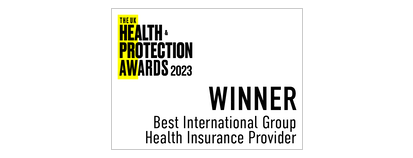What is expatriate health insurance?
Expatriate Health Insurance provides medical coverage for individuals called expats who reside in a foreign country for a prolonged period, usually for work-related reasons. If you're a professional living and working overseas, you can ensure your medical needs are met by choosing a suitable international health insurance plan.
Our International health insurance plans include cover for a wide range of in-patient and day-care treatments as well as an optional level of cover such as out-patient, dental, maternity and repatriation benefits. Our plans also include treatment for covid-19
Your cover is also subject to:
• Policy definitions and exclusions
• Any special conditions shown on your Insurance Certificate (and on the Special Condition Form issued before the policy comes into effect, where relevant).
• Any policy endorsements, policy terms and conditions and any other legal requirements.
• Costs being reasonable and customary in accordance with country of treatment, standard and generally accepted medical procedures. If we consider a claim to be inappropriate, we reserve the right to decline or reduce the amount we pay.
Cover is not provided if any element of the cover, benefit, activity, business or underlying business violates any applicable sanction law or regulations of the United Nations, the European Union or any other applicable economic or trade sanction law or regulations.
Please check your Insurance Certificate, Benefit Guide and Table of Benefits to find out more.
The expatriate health insurance cover includes:
![]()
Doctor visits
![]()
Hospitalisation
![]()
Prescription drugs
![]()
Emergency medical care
![]()
Preventive care
![]()
Wellness services
Digital or in-person support available around the clock
International Health Insurance Plans for Expats
Our expat health insurance plans offer excellent benefits for expat professionals, and optional extras to help you tailor your cover according to your needs.
Care Pro
£ 3,100,000/
€3,703,705/
US$ 5,000,000/
CHF 4,814,815
Care Plus
£ 2,460,000 /
€ 2,963,000 /
US$ 4,000,000 /
CHF 3,852,000
Care
£ 1,575,000 /
€ 1,851,850 /
US$2,500,000 /
CHF2,407,400
- Where necessary treatment is not available locally, we will evacuate the insured person to the nearest appropriate medical centre
- Where ongoing treatment is required, we will cover hotel accommodation costs
- Evacuation in the event of unavailability of adequately screened blood
- If medical necessity prevents an immediate return trip following discharge from an in-patient episode of care, we will cover hotel accommodation costs
US$ 1,350 / CHF 1,300
Global Health Services
Offers access to a range of 24/7 multilingual support services as follows:
- Counselling – confidential and professional support (in-person, phone and video)
- Legal and financial referral services
- Critical incident support
- Wellness website access
Learn more about ourExpat Assistance Programme.
24/7 access to personal security information and advice for all your travel safety queries. This includes:
- Emergency Security Assistance Hotline (not a free phone number)
- Country intelligence and security advice
- Daily security news and travel safety alerts
Learn more about our Travel Security Services.
Optional Core Plan Deductibles
Deductible amount
No deductible
£374/€450/ US$610/ CHF585
£625/€750/ US$1,015/ CHF975
£1,245/€1,500/ US$2,025/ CHF1,950
£2,490/€3,000/ US$4,050/ CHF3,900
£4,980/ €6,000/ US$8,100/ CHF7,800
£8,300/€10,000/ US$13,500/ CHF13,000
Discount on your Core plan premium when you don’t add a maternity plan
0% premium discount
5% premium discount
10% premium discount
20% premium discount
35% premium discount
50% premium discount
60% premium discount
Discount on your Core plan premium when you add a maternity plan
0% premium discount
2.5% premium discount
5% premium discount
10% premium discount
17.5% premium discount
25% premium discount
30% premium discount

Get your health cover in a few simple steps
Getting your policy is much easier and faster when you choose our Moratorium underwriting option.
There are no medical questionnaires to complete. It’s hassle free.

10% off your international health insurance for life!
Promocode: LIFE10
Selected plans only. T&Cs Apply.
Discover the benefits of being a Care Pro
My Expat Life
Why choose us as your trusted health insurer?
FAQs
You can receive treatment in any country within your area of cover, as shown in your Insurance Certificate.
If the treatment you need is available locally but you choose to travel to another country in your area of cover, we will reimburse all eligible medical costs incurred within the terms of your policy; except for your travel expenses.
If the eligible treatment is not available locally, and your cover includes “Medical evacuation”, we will also cover travel costs to the nearest suitable medical facility. To claim for medical and travel expenses incurred in these circumstances, you will need to complete and submit the Pre-authorisation Form before travelling.
You are covered for eligible costs incurred in your home country, provided that your home country is in your area of cover
This is the geographical territory where your cover is valid. We offer multiple geographical area of cover options – please check your Insurance Certificate to confirm which one applies to you.
For example, if your area of cover is “Worldwide”, this means that your cover will be valid everywhere* in the world. If your area of cover is “Africa”, then your cover will be valid everywhere* in Africa.
Below you will find the definition related to “Cancer screening” that apply to our standard international healthcare plans – these may vary slightly depending on the plans you have, so please consult your Benefit Guide and Table of Benefits to confirm what you are covered for.
Cancer screening for the early detection of illness or disease are: health checks, tests and examinations, performed at an appropriate age interval, that are undertaken without any clinical symptoms being present.
Checks are limited to:
- Annual gynaecological exam
- Mammogram (every two years for women aged 45+, or younger where a family history exists)
- Annual prostate screening (yearly for men aged 50+, or younger where a family history exists)
- Colonoscopy (every five years for members aged 50+, or 40+ where a family history exists)
- Annual faecal occult blood test
- BRCA1 and BRCA2 genetic test (where a direct family history exists and where included in your Table of Benefit)
Separate to the Cancer screening benefit, some out-patient plans also include additional preventative screening cover under “Health and wellbeing checks”. To learn more about our comprehensive cancer coverage, view our brochure
If you are already a member, please see your Table of Benefits and Benefit Guide to confirm your coverage
Any dental benefits available to you are shown on your Table of Benefits along with any deductibles, co-payments, benefit limits, waiting periods or age restrictions which apply. Your Table of Benefits should be read in conjunction with your Benefit Guide for full details of your dental benefits, including definitions and/or exclusions.
For your convenience, below we list the definitions related to dental benefits that apply to our standard international healthcare plans – these may vary slightly depending on the plans you have, so please consult your Benefit Guide and Table of Benefits to confirm the definitions available to you:
Dental-related definitions:
- Dental treatment includes an annual check-up, simple fillings related to cavities or decay, root canal treatment and dental prescription drugs.
- Dental prescription drugs are those prescribed by a dentist for the treatment of a dental inflammation or infection. The prescription drugs must be proven to be effective for the condition and recognised by the pharmaceutical regulator in a given country. This does not include mouthwashes, fluoride products, antiseptic gels and toothpastes.
- Dental surgery includes the surgical extraction of teeth, as well as other tooth related surgical procedures such as apicoectomy and dental prescription drugs. All investigative procedures necessary to establish the need for dental surgery such as laboratory tests, X-rays, CT scans and MRI(s) are included under this benefit. Dental surgery does not cover any surgical treatment that is related to dental implants.
- Dental prostheses includes crowns, inlays, onlays, adhesive reconstructions/restorations, bridges and dentures as well as all necessary and ancillary treatment required. Dental implants are not covered under the ‘Dental prostheses’ benefit, but may be included in your cover under a separate ‘Dental implants’ benefit
- Periodontics refers to dental treatment related to gum disease.
- Orthodontics is the use of devices to correct malocclusion (misalignment of your teeth and bite). We only cover orthodontic treatment that meets the medical necessity criteria described below. As the criteria is very technical, please contact us before starting treatment so we can verify if your treatment meets the criteria.
Medical Necessity Criteria:
a) Increased overjet > 6mm but <= 9 mm
b) Reverse overjet > 3.5 mm with no masticatory or speech difficulties
c) Anterior or posterior crossbites with > 2 mm discrepancy between the retruded contact position and intercuspal position
d) Severe displacements of teeth > 4
e) Extreme lateral or anterior open bites > 4 mm
f) Increased and complete overbite with gingival or palatal trauma
g) Less extensive hypodontia requiring pre-restorative orthodontics or orthodontic space closure to obviate the need for a prosthesis
h) Posterior lingual crossbite with no functional occlusal contact in one or more buccal segments
i) Reverse overjet > 1 mm but < 3.5 mm with recorded masticatory and speech difficulties
j) Partially erupted teeth, tipped and impacted against adjacent teeth
k) Existing supernumerary teeth
You will need to send us some supporting information to show that your treatment is medically necessary and therefore covered by your plan. The information we ask for may include, but is not limited to:
- A medical report issued by the specialist, stating the diagnosis (type of malocclusion) and a description of your symptoms caused by the orthodontic problem.
- A treatment plan showing the estimated duration and cost of the treatment and the type/material of the appliance used.
- The payment arrangement agreed with the medical provider.
- Proof of payment for orthodontic treatment.
- Photographs of both jaws clearly showing dentition before the treatment.
- Clinical photographs of the jaws in central occlusion from frontal and lateral views.
- Orthopantomogram (panoramic x-ray).
- Profile x-ray (cephalometric x-ray).
- Any other document we may need to assess the claim.
We will only cover the cost of standard metallic braces and/or standard removable appliances. However, we’ll cover cosmetic appliances such as lingual braces and invisible aligners up to the cost of metallic braces, subject to the “Orthodontic treatment” benefit limit.
Coverage for pre-existing medical conditions (including pre-existing chronic conditions) depends on the medical underwriting terms you accepted.
- For policies which were fully medically underwritten, pre-existing conditions are generally covered unless we say otherwise in your policy documents.
- For policies with moratorium, pre-existing conditions are only eligible for coverage once you’ve completed a continuous 24-month period after your start date and have not had symptoms, needed or received treatment, medication, a special diet or advice, or had any other indications of the condition during that time.
For further information, please contact our Sales team.
Moratorium underwriting sets a waiting period for pre-existing medical conditions to limit the insurance risk. This means that:
- You won't need to tell us about pre-existing conditions of any member to be covered when you apply.
- There will be a 24-month waiting period before claims for any pre-existing medical conditions may become eligible.
- Pre-existing medical conditions may be covered, provided the member did not have symptoms, needed or received treatment, medication, a special diet or advice, or had any other indications of the condition. This is suitable for individuals or groups where members have no pre-existing conditions.
- Claims Process may be longer as each time we receive a claim, we'll look at the member medical history. We may also ask for additional information to understand if the symptom or condition is new or pre-existing.
- This option is available to individuals or groups with 3 to 9 policies
- Availability of Moratorium Underwriting is dependent on geographical location and the relevant local country regulations in place.
Full medical underwriting is when we assess the insurance risk before cover starts. This means that:
- You’ll be asked to complete a medical questionnaire for each person to be covered, telling us about pre-existing conditions when you apply.
- Pre-existing conditions may not be covered (or there may be a surcharge to cover pre-existing conditions). Members will be asked to complete an application form disclosing their medical history before cover starts. Our underwriting team will then assess the information and decide if we are able to offer cover for medical conditions disclosed on the form.
- Claims process is shorter because we already know if pre-existing conditions are covered.
- This option is available to individuals or groups with 3 to 9 policies.
Real stories, real people.
Here’s the story behind what we do and why we do it. Our mission is to help you be well.

ITIJ Award Winner

ITIJ Award Winner

EFMA & Accenture Innovation in Insurance Awards Winner

EFMA & Accenture Innovation in Insurance Awards Winner

UK Health & Protection Award Win

UK Health & Protection Award Win



